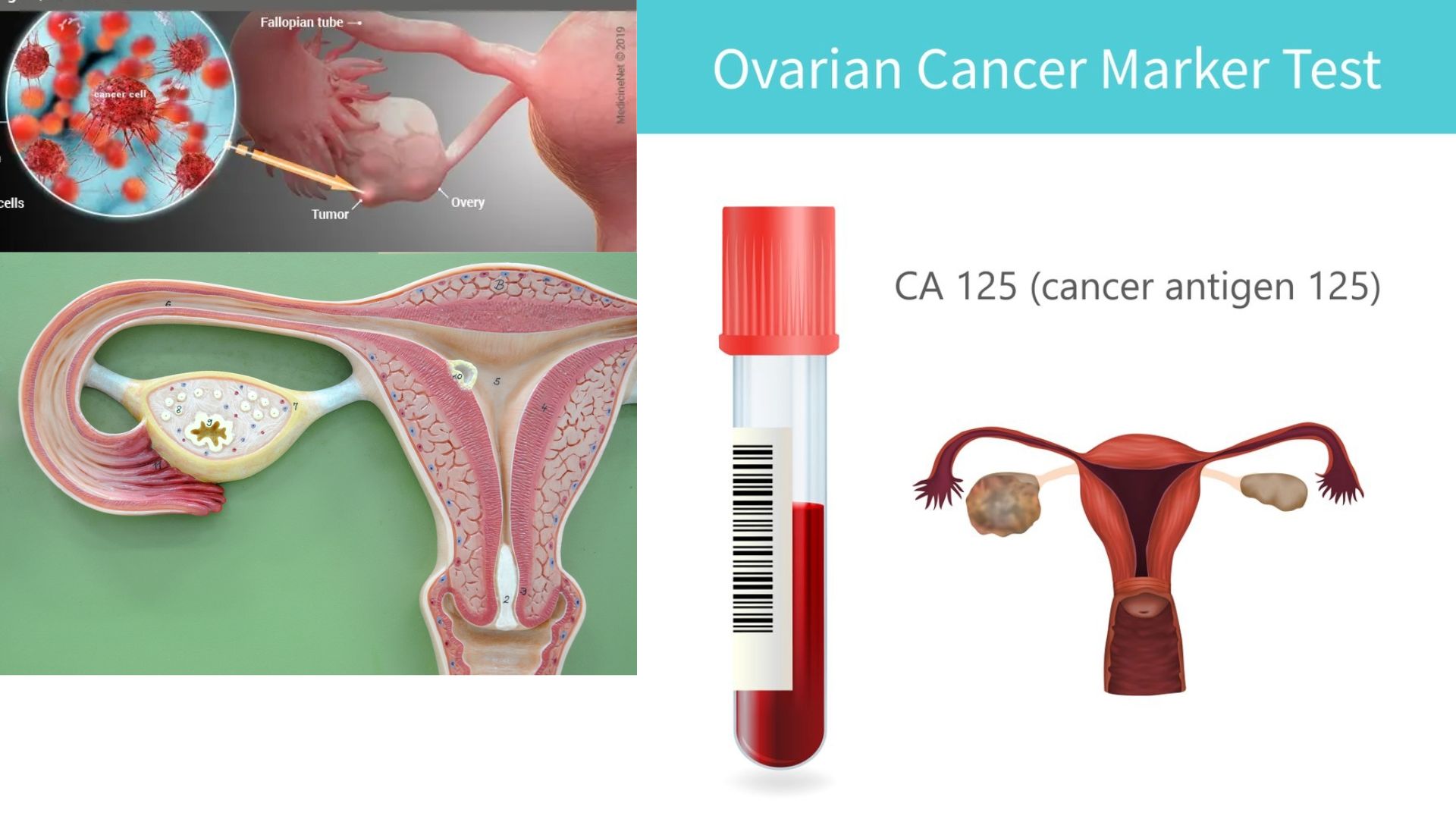When doctors talk about cancer tests or tumor markers, one name that often comes up is CA-125. Many patients first hear about this test when they are being evaluated for ovarian cancer or other gynecological conditions. But what exactly is CA-125? Is it only linked to cancer? Can healthy people have high levels too?

What is CA-125?
CA-125 (Cancer Antigen 125) is a type of protein that is found in the blood. It is produced by certain cells in the body, including those in the female reproductive system. Normally, CA-125 levels are low. But in some medical conditions—especially ovarian cancer—the levels can increase.
That’s why CA-125 is known as a tumor marker. Doctors use it as a clue to help detect or monitor certain diseases, particularly cancers affecting the ovaries.
Why is the CA-125 Test Done?
The CA-125 test is not a routine blood test. Instead, doctors order it in specific situations. The main uses include:
1. Monitoring Ovarian Cancer
- After a woman is diagnosed with ovarian cancer, CA-125 is often measured to see how the cancer is responding to treatment.
- If the level goes down after chemotherapy or surgery, it usually means the treatment is working.
- Rising levels during follow-up may signal that the cancer has come back.
2. Supporting Diagnosis of Ovarian Cancer
- In women who have symptoms such as bloating, abdominal pain, or unexplained weight changes, a CA-125 test may be ordered along with imaging tests (like ultrasound or CT scan).
- High CA-125 levels can support a suspicion of ovarian cancer but cannot confirm it alone.
3. Evaluating Other Conditions
- Elevated CA-125 is not only seen in cancer. Conditions like endometriosis, uterine fibroids, pelvic inflammatory disease, and even pregnancy can cause higher levels.
- Doctors sometimes use the test to understand whether symptoms may be related to these conditions.
4. Screening in High-Risk Women
- For women with a strong family history of ovarian cancer or carrying BRCA1/BRCA2 gene mutations, doctors may recommend CA-125 testing as part of regular check-ups.
- However, it is not a perfect screening tool (more on this below).
Normal Range of CA-125
In most laboratories, the normal CA-125 level is below 35 units/milliliter (U/mL).
- Below 35 U/mL: Usually considered normal, but a small number of ovarian cancers can still occur with normal CA-125.
- Above 35 U/mL: May suggest ovarian cancer or other conditions. The higher the number, the more likely it is linked to cancer, but further tests are always needed.
👉 Key Point: A high CA-125 does not always mean cancer, and a normal CA-125 does not always rule it out.
Conditions That Can Increase CA-125 Levels
While CA-125 is strongly linked to ovarian cancer, many non-cancerous conditions can also cause elevated levels.
Non-Cancer Causes of High CA-125
- Menstruation (periods)
- Pregnancy
- Endometriosis
- Uterine fibroids
- Pelvic inflammatory disease (PID)
- Liver disease (hepatitis, cirrhosis)
- Recent abdominal surgery
Cancer-Related Causes of High CA-125
- Ovarian cancer (most common link)
- Uterine cancer
- Fallopian tube cancer
- Pancreatic cancer
- Breast cancer
- Lung cancer
Because of this overlap, doctors never rely on CA-125 alone for making a cancer diagnosis.
How is the CA-125 Test Done?
The test is simple and requires only a blood sample.
Steps:
- A nurse or technician takes a blood sample from your arm.
- The blood is sent to a laboratory where CA-125 levels are measured.
- Results are usually available within 24–48 hours.
There is no special preparation needed. You can eat and drink normally before the test unless your doctor gives different instructions.
How Doctors Interpret CA-125 Results
Interpreting CA-125 requires looking at the whole clinical picture—not just the number.
Example Interpretations:
- Mild elevation (40–100 U/mL): Could be due to menstruation, fibroids, or endometriosis. Needs further evaluation.
- Moderate elevation (100–200 U/mL): Suspicious, especially in postmenopausal women. Imaging tests are recommended.
- High elevation (>200 U/mL): Strongly suggests ovarian cancer or another malignancy, but confirmation with imaging and biopsy is required.
👉 Doctors often track trends over time rather than relying on a single value. A steady rise in CA-125 is more concerning than one isolated result.
Limitations of the CA-125 Test
While CA-125 is a useful tool, it has several limitations:
- Not a Screening Test for the General Population
- It is not accurate enough to be used as a routine screening test for all women.
- Many women with ovarian cancer have normal CA-125 levels, especially in the early stages.
- False Positives
- Many non-cancer conditions can raise CA-125, leading to unnecessary anxiety and additional testing.
- False Negatives
- A normal CA-125 does not guarantee the absence of cancer. Some ovarian cancers do not produce CA-125.
- Limited Use in Men
- CA-125 is rarely used in men, though it can sometimes be elevated in conditions like pancreatic or lung cancer.
CA-125 and Ovarian Cancer: The Strongest Link
Among all conditions, ovarian cancer is the one most closely associated with CA-125.
Key Facts:
- Around 80% of women with advanced ovarian cancer have high CA-125 levels.
- However, only 50% of women with early-stage ovarian cancer show elevated levels.
- That’s why relying only on CA-125 for early detection is not recommended.
Doctors often combine CA-125 with transvaginal ultrasound to improve detection in women at high risk.
What to Do if Your CA-125 is High
Hearing that your CA-125 is elevated can be worrying. But remember—it does not always mean cancer.
Steps Your Doctor May Recommend:
- Repeat the test after a few weeks to see if the level is rising, falling, or stable.
- Pelvic ultrasound or CT scan to look for abnormalities in the ovaries or uterus.
- Physical examination and review of medical history.
- Referral to a gynecologic oncologist if cancer is suspected.
- Biopsy or surgery if imaging shows suspicious growths.
👉 Never panic from a single result. Always discuss the numbers in detail with your doctor.
How Patients Can Prepare for a CA-125 Test
- Stay calm: Stress won’t affect the test results.
- Tell your doctor if you are menstruating, pregnant, or have known gynecological conditions.
- Bring your previous reports: Comparing new results with old ones helps doctors see trends.
FAQs About CA-125
1. Can CA-125 be normal in ovarian cancer?
Yes. Up to 50% of early-stage ovarian cancers show normal CA-125 levels.
2. Should healthy women take the CA-125 test?
No. It is not recommended as a general screening test because of false positives and negatives.
3. Can men have a CA-125 test?
Yes, but it’s rarely used. In men, elevated CA-125 may point to cancers such as lung or pancreatic cancer.
4. How often should high-risk women test CA-125?
Doctors may suggest testing every 6–12 months along with imaging, especially in women with genetic risks.
5. Is CA-125 useful after treatment?
Yes. It is very useful in monitoring ovarian cancer recurrence after surgery or chemotherapy.
Conclusion
The CA-125 test is an important tool in the diagnosis and monitoring of ovarian cancer, but it is not perfect. Many other conditions can raise CA-125 levels, and not all cancers show high values.
The best way to use CA-125 is in combination with other tests, scans, and medical evaluation. If you or someone you know has an abnormal CA-125 result, the most important step is to talk to a doctor, not to panic.
By understanding the test’s role and limitations, patients and caregivers can make informed decisions and avoid unnecessary fear.
